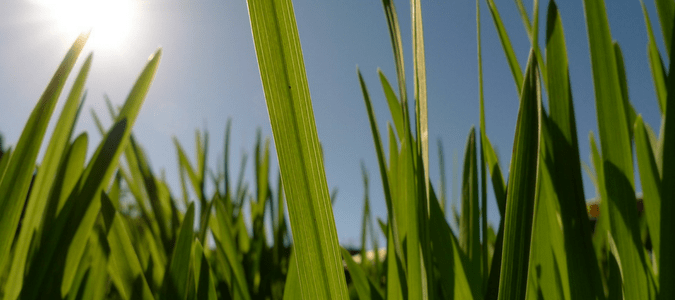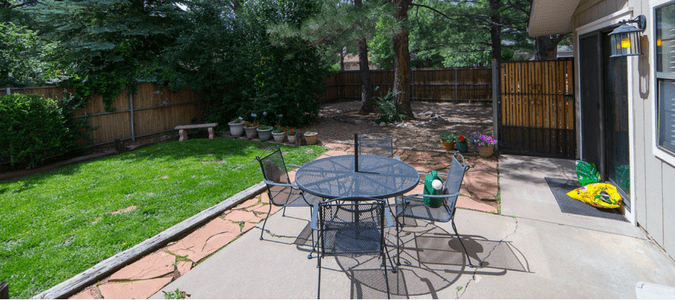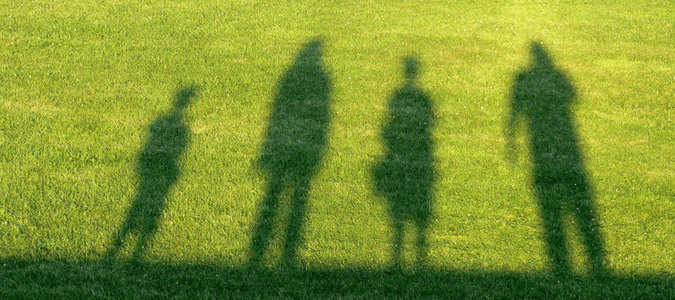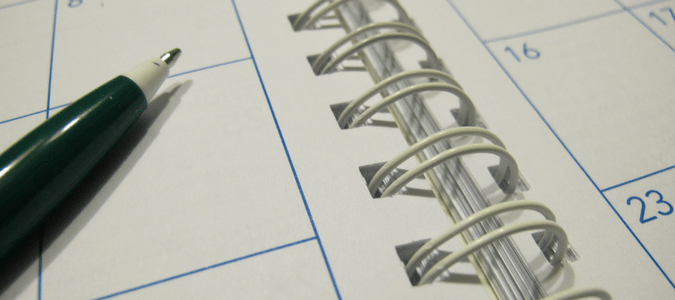
No one likes having a patchy lawn. So last year you decided to do something about it. You seeded new grass into problem areas and waited for it to grow. Grow it did—until it started dying off. What happened? How can you stop this from happening again and get your lawn back to the healthy, vibrant green you remember? Lawn care professionals understand that knowing when to fertilize new grass can make the difference between a thriving yard and grass that is less equipped to handle the brutal Southern heat.
In this post, we’ll discuss when to fertilize new turf, the difference between lawn starter fertilizer and regular fertilizer, how often to apply starter fertilizer and the answer to the question: When should I fertilize my lawn after seeding?
What Will I Learn?
- Do I Really Have to Fertilize My Grass?
- Lawn Starter Fertilizer vs. Regular Fertilizer
- Knowing When to Fertilize New Sod
- How Ofter to Apply Starter Fertilizer on New Grass
- Determine the Type and Amount of Fertilizer for your New Grass
- When to Fertilize your Lawn after Seeding
- Get Professional Help to Keep your Lawn Looking Great
Do I Really Have To Fertilize My Grass?
Of course, you don’t have to fertilize! But you’re probably going to want to.
Why?
Well, let’s talk about what lawns need in order to grow and stay healthy and green. Namely, nutrients.
These nutrients can come from organic matter and minerals that are already in the soil. This nourishment can also be derived from fallen leaves, grass clippings and the like.
The sad truth is that the soil in large parts of Texas and other parts of the south isn’t all that nutrient-rich, and there’s probably not enough naturally-occurring organic matter to make up the difference in most cases.
The impact of these types of soil on your lawn? More insects. More weeds. A higher chance of disease, including yard fungus. Increased chance of erosion. Your grass might thin. You’ll suffer patchiness and increased runoff.
Basically, all kinds of bad things that you don’t want.
Fertilizer can provide the additional nutrients your yard needs to prevent these problems and keep your grass healthy and looking good.
Unfortunately, fertilization isn’t as simple as deciding to do it and picking up some fertilizer from your nearest home improvement store. You have to know what’s best to use. When to use it. How often.

Lawn Starter Fertilizer vs Regular Fertilizer
Would you feed a newborn baby a slice of pizza? Of course you wouldn’t. And obviously, that’s a ridiculous question.
Because you know that babies have special needs. In order to grow and develop in the beginning, it is vital that they receive the nutrients they need from their mother’s milk or baby formula.
Here’s the thing, though. A lot of people do the equivalent of feeding a newborn a slice of pizza when they try to fertilize new grass.
How so?
They use regular fertilizer instead of starter fertilizer.
Both can provide plants with valuable nutrients, but they are not interchangeable. The nutrients they contain differ, and plants need each type at different stages of their life cycle.
Regular fertilizer contains a mix of nitrogen, potassium and phosphorus at a 1-2-1 ratio. That’s great for established plants, but not so wonderful for seedlings.
In fact, the main ingredient in most starter fertilizers is phosphorous, which makes grass seeds much more likely to germinate and sprout. Many also contain quick-release nitrogen to assist in germination and the development of the seed. In other words, they are specially formulated for seedlings.
So, when do you add starter fertilizer to your new turf?

Knowing When To Fertilize New Sod Matters
Many people think of fertilization as something that happens after plants are already in the ground–or after turf is installed. In reality, however, waiting this long is a bad idea.
The best times to fertilize your new sod are either:
- Before you sow the seeds, or
- While the seeds are being sown.
Fertilizing earlier will provide your grass seeds with a nutritional “boost” that can help as they try to take root and establish themselves.
Here’s how you do it.
Before installing your new turf, till the starter fertilizer into the ground with a hoe.
Be sure that none of the fertilizer goes deeper than four inches. This is incredibly important, because when fertilizer goes too deep, it can burn the roots of your grass.
Once you’re done, level out the soil and you can install your new sod.

How Often To Apply Starter Fertilizer On New Grass
When do you reapply your starter fertilizer after the sod is installed and the grass starts growing in? You don’t!
Seriously. This is one of the most important things to remember: starter fertilizer should only be used before a new lawn is installed.
Why? Because it can actually damage your lawn if you use it later.
Remember the baby analogy from earlier? Well, after your lawn is installed, it’s no longer a baby, so you need to switch to more appropriate “food.”
In other words, the next time you fertilize you need to use regular fertilizer that is appropriate for the makeup of your soil and the size of your fertilization area.
Determining The Type And Amount Of Fertilizer For Your New Grass
Since the fertilizer you choose should be based on soil makeup and growth area, start by learning those two things.
Measure the square footage of the new grass you’re trying to grow in order to determine how much fertilizer you need to purchase. Then get a soil test done to learn which nutrients are present in your soil and which ones you’re lacking.
Having a soil test done may sound complicated, scary, expensive or all three, but it’s actually really easy. In most areas, there are a number of options available to you. Texas A&M even allows you to send in soil samples and get results back!
Once you know the makeup of your soil, you can determine which fertilizer ratio is best for your lawn. Many homeowners discover that their lawns already contain enough phosphorous and potassium and opt for nitrogen-only fertilizer.
If you do use phosphorous, be careful. Phosphorous levels can easily build up too much in soil, resulting in runoff that ends up in surface waters. This is bad for the environment because it can harm fish habitats and increase algal blooms.
Some homeowners are also looking for advice on choosing an eco-friendly fertilizer for your lawn. As more options become available, organic fertilizers have grown in popularity as individuals are working to find a balance between growing and maintaining a healthy lawn and minimizing the use of chemical products on their property.

When Should I Fertilize My Lawn After Seeding?
Now that your grass has been seeded and you have your new regular fertilizer, how soon should you use it? As much as you might want to encourage growth and hurry the process along as quickly as possible, it’s best to wait before re-fertilizing your new grass.
How long? At least four weeks, and possibly as many as eight.
If you give in and re-fertilize too early, the nutrients will not be absorbed by the roots, and you can have runoff that, as we already mentioned, can make its way into the water supply or harm water-dwelling creatures. Moreover, over-fertilizing can actually leach more nutrients from the soil, leaving a deficiency of nutrients when your new turf is finally ready to be replenished.
Save yourself frustration and possible contamination: do not re-fertilize early. After this, you can adhere to the following regular annual fertilization schedule:
Summer Fertilization
Technically late spring and early summer fertilization is mostly for new and neglected lawns, but if you’re reading this, your lawn likely falls into one or both of those categories.
You can give your grass a bit of extra help by applying slow-release nitrogen fertilizer in 45- to 60-day intervals throughout the season. Using slow-release nitrogen will benefit your lawn without spurring uncontrolled growth that can force you to have to mow more frequently.
Fall Fertilization
Why fertilize in the fall? There are a number of reasons.
One benefit of fall fertilization is that it bolsters lawn density. In addition, applying fertilizer in the fall helps to protect against winter weeds. Another benefit is that your lawn color tends to be better throughout the fall if you give your grass some added nourishment. Lastly, fertilizing assists in the recovery of your grass in the spring.
You’ll want to use fertilizer with modest nitrogen rates (a pound or less per 1,000 sq. ft.) so that it doesn’t leach or carry over. Additionally, you’ll want to make sure you apply your last batch of fertilizer well before the first frost of the season. These vary by region, but in Texas, the absolute latest date for yearly fertilization should be November 1.
Spring Fertilization
Generally speaking, the first time you fertilize in the spring will likely be sometime between the beginning of March and the middle of April. Obviously, this can vary quite a bit by region, so another way to tell when you begin is to pay attention to your lawn.
Specifically, the grass should start to turn green and require mowing at least twice before it’s time to fertilize for the spring. Make sure it’s actually grass that needs mowing, too–weeds may need to be cut well before this, but they don’t count.
Let ABC Nurture Your New Grass For You
Does implementing a year-round fertilization schedule sound like a lot of work? It can be if you do it all on your own. Plus, there are many ways that you can make a mistake, which will put you right back at square one. Avoid these problems by letting ABC Home & Commercial Services do the hard work for you. Our professional lawn care technicians have been keeping lawns all across the south looking their best for generations, and we can help your yard, too. Schedule a service today.
